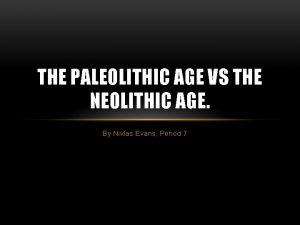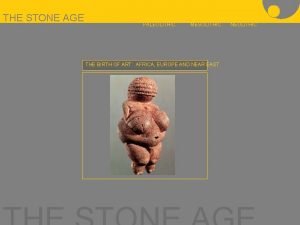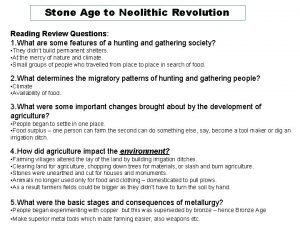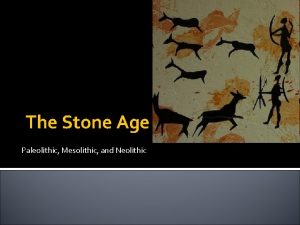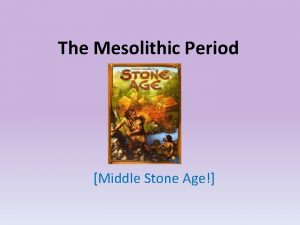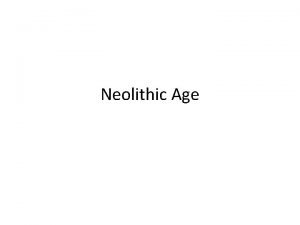Mesolithic Middle Stone Age Neolithic New Stone Age








- Slides: 8

Mesolithic- Middle Stone Age Neolithic- New Stone Age Artworks. Neolithic Plastered Skull Great Stone Tower Stonehenge

Mesolithic • Around 9000 BCE, the ice that covered much of northern Europe during the Paleolithic period melted as the climate grew warmer. The reindeer migrated north, and the wooly mammoth and rhinoceros disappeared. The Paleolithic gave way to a transitional period, the Mesolithic, when Europe became climatically, geographically, and biologically much as it is today.

Neolithic • Several thousand years after the Mesolithic Period, at different times, in different parts of the globe, a new age, the Neolithic, dawned. • Human beings began to settle in fixed abodes and to domesticate plants and animals. Their food supply assured, many groups changed from hunters to herders, to farmers, and finally to towns people. • The new sedentary societies of the Neolithic age originated systematic agriculture, weaving, metal working, pottery, and counting and recording with tokens. Soon, these innovations spread from Mesopotamia to northern Syria, Anatolia (Turkey), and Egypt.

Great stone tower built into the settlement wall, Jericho, ca. 8000 -7000 BCE. • • • By 7000 BCE, agriculture was well established in at least three Near Eastern regions: ancient Palestine, Iran, and Anatolia. Although no remains of domestic cereals have been found that can be dated before 7000 BCE, the advanced state of agriculture at that time presupposes a long development. Indeed, the very existence of a town such as Jericho gives strong support to this assumption. The site of Jericho—a plateau in the Jordan River valley with an unfailing spring– was occupied by a small village as early as the 9 th millennium BCE. This village underwent spectacular development around 8000 BCE, when a new Neolithic town covering about 10 acres was built. Its mud-brick houses sat on round or oval stone foundations and had roofs of branches covered with earth. As the town’s wealth grew and powerful neighbors established themselves. The need for protection resulted in the first known permanent stone fortifications. By approximately 7500 BCE, the town, estimated to have had a population of more than 2, 000 people, was surrounded by a wide rock-cut ditch and a 5 -foot-thick wall. Into this wall, which has been preserved to a height of almost 13 ft, was built a great circular, stone tower, 28 ft high. Almost 33 ft in diameter at the base, the tower has an inner stair-way leading to its summit. This structure was built with only simple stone tools & was a tremendous technological achievement. It constitutes the beginning of the long history of monumental architecture.

Plastered Sculls, Jericho & Ain Ghazal, Jordan ca 7 -6, 000 BCE • • • The symbolic meaning of the statues and the plastered skull remains unknown. Endowing a skull with human features molded from plaster may have been a way to pay homage to the deceased, particularly to revered members of the community, Simmons and his colleagues suggest. Whatever its significance to the prehistoric inhabitants of 'Ain Ghazal, "the skull stands as silent testimony to the power of ritual at a time when humankind was still in the experimental stages of settled village life, " the researchers conclude. A plastered skull was made by modeling a plaster replica of skin and features onto a human skull. In some cases cowry shells were used for eyes, and sometimes they were painted using cinnabar or other iron-rich element.

• • • Stonehenge, Salisbury Plain, Wiltshire, England, ca. 2550 -1600. Circle is 97’ in diameter; trilithons approx. 24’high. Megaliths & Henges- As Early as 4000 BCE, local Neolithic populations in several areas developed a monumental architecture employing massive rough-cut stones. The very dimensions of the stones, some as high as 17 feet and weighing as much as 50 tons, have prompted historians to call them megaliths (great stones). Although Megalithic monuments are plentiful throughout Europe, the arrangement of huge stones in a circle (called a cromlech or henge), often surrounded by a ditch, is almost entirely limited to Britain. The most imposing today is Stonehenge on the Salisbury Plain in Southern England. Stonehenge is a complex of rough-cut sarsen (a form of sandstone) stones and smaller “bluestones” (various volcanic rocks). Outermost is a ring, almost 100 feet in diameter, of large monoliths of sarsen stones capped by lintels (a stone “beam” used to span an opening. Next is a ring of bluestones, which, in turn, encircles a horseshoe (open end facing east) of trilithons (three-stone constructions)– five linteltopped pairs of the largest sarsens, each weighing 45 -50 tons. Standing apart and to the east (outside our photograph at the lower right corner) is the “heel stone, ” which, for a person looking outward from the center of the complex, would have marked the point where the sun rose at the summer solstice. Stonehenge was probably built in several phases in the centuries before and after 2000 BCE. It seems to have been a kind of astronomical observatory. The mysterious structures were believed in the Middle Ages to have been the work of the magician Merlin of the King Arthur legend, who spirited them from Ireland. Most archaeologists now consider Stonehenge a remarkably accurate solar calendar. This achievement is testimony to the rapidly developing intellectual powers of Neolithic humans.

Stonehenge, Salisbury Plain, Wiltshire, England, ca. 2550 -1600. Circle is 97’ in diameter; trilithons approx. 24’high.

Citations • "The dead and the plastered - plastered skull found at an archaeological excavation in Jordan". Science News. Find. Articles. com. 01 Oct, 2010. http: //findarticles. com/p/articles/mi_m 1200/is_n 19_v 137/ai_9028523/ • Gardner’s Art Through The Ages, 12 th Edition. Fred S. Kleiner Christin J. Mamiya.



